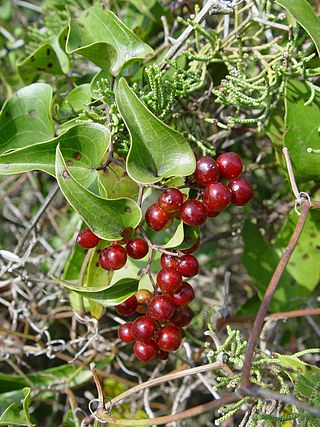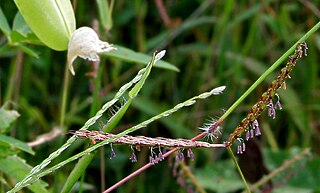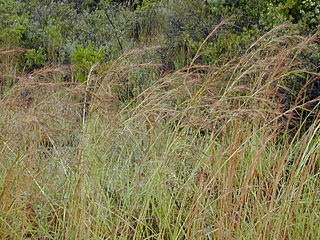
Saccharum is a genus of tall perennial plants of the broomsedge tribe within the grass family.

Smilax is a genus of about 300–350 species, found in the tropics and subtropics worldwide. They are climbing flowering plants, many of which are woody and/or thorny, in the monocotyledon family Smilacaceae, native throughout the tropical and subtropical regions of the world. Common names include catbriers, greenbriers, prickly-ivys and smilaxes. Sarsaparilla is a name used specifically for the Neotropical S. ornata as well as a catch-all term in particular for American species. Occasionally, the non-woody species such as the smooth herbaceous greenbrier are separated as genus Nemexia; they are commonly known by the rather ambiguous name carrion flowers.

Andropogon is a widespread genus of plants in the grass family, native to much of Asia, Africa, and the Americas, as well as Southern Europe and various oceanic islands.

Pithecellobium is a genus of flowering plants in the family Fabaceae. It includes approximately 23 species from the tropical Americas, ranging from Mexico to Peru and northern Brazil, including the Caribbean Islands and Florida.

Bothriochloa is a common and widespread genus of plants in the grass family native to many countries on all inhabited continents and many islands. They are often called beardgrass, bluegrass or bluestem. Some species are invasive in areas where they have been introduced.

Ischaemum is a genus in the tribe Andropogoneae, belonging to the grass family, widespread in tropical and semitropical regions in many countries. Many species are known commonly as murainagrass.

Spermacoce or false buttonweed is a genus of flowering plants in the family Rubiaceae. It comprises about 275 species found throughout the tropics and subtropics. Its highest diversity is found in the Americas, followed by Africa, Australia and Asia.

Hyparrhenia is a genus of grasses. Many species are known commonly as thatching grass.

Eulalia is a genus of Asian, African, and Australian plants in the grass family.

Leersia is a genus of plants in the grass family which includes species known generally as cutgrasses.
Pseudechinolaena is a genus of tropical and subtropical plants in the grass family, all but one species endemic to Madagascar.
Loxodera is a genus of African plants in the grass family.

Coelorachis is a genus of plants in the grass family, widespread across much of Asia, Africa, Australia and the Americas.

Schizachyrium is a widespread genus of plants in the grass family. The name is derived from the Ancient Greek words σχίζειν, meaning "to split," and ἄχυρον, meaning "chaff." It refers to either the glume or the toothed lemmas.

Urelytrum is a genus of African plants in the grass family.

Rhytachne is a genus of plants in the grass family. They grow principally in wet savannahs in Africa and the Americas. More specifically, they tend to prefer transitional zones between marshes and drier upland savannahs. In the Americas, the genus can be found from southern Mexico and Cuba south to northern Argentina, while in Africa it is present in Sub-Saharan Africa, including in Madagascar. Twelve species are included, of which nine are African, two are American, and one, Rhytachne subgibbosa, is found on both continents. The genus is closely related to Coelorachis.

Rottboellia is a genus of African, Asian, and Australian plants in the grass family.

Limnobium, common names spongeplant and American frogbit, is a group of aquatic plants in the Hydrocharitaceae described as a genus in 1814. It is widespread in freshwater environments in Latin America, the West Indies, and the United States.
Adiantum concinnum, locally known as cilantrillo, culantrillo, or the maidenhair fern is a rhizomatous geophyte used as a local herbal medicine in many South and Central American cultures.
















